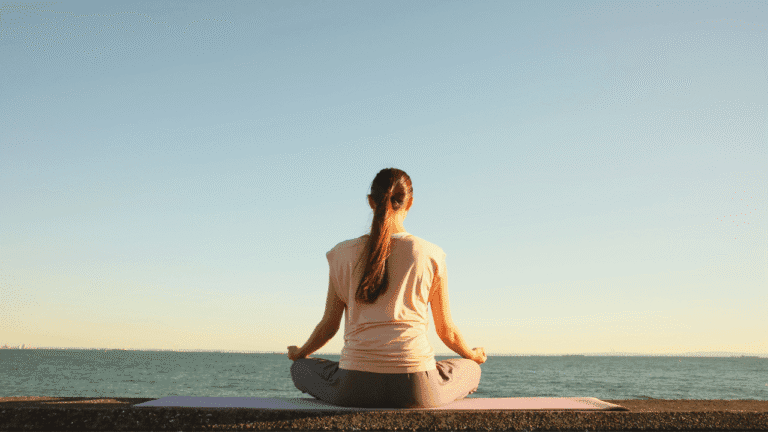Mindfulness Breathing Basics: Calm Your Mind, Find Clarity

Are you looking to reduce stress and improve your overall well-being? Mindfulness breathing basics may be just what you need. This foundational practice involves focusing your attention on the breath, allowing you to cultivate relaxation and mental clarity. Whether you’re a beginner or have some experience with mindfulness, these techniques can help you harness the power of your breath.
From mindfulness breath exercises to deep breathing techniques, there are various approaches you can explore. By incorporating mindfulness breath awareness into your daily routine, you can experience the transformative effects of this practice.
During breath awareness meditation, you’ll learn to observe the natural flow of your breath without trying to change it. As thoughts and bodily sensations arise, you gently redirect your focus back to the breath. This exercise can be done for just a few minutes or as long as 15 minutes a day.
Studies have shown that mindfulness-based stress reduction techniques, including mindful breathing, can improve resilience, reduce stress, and alleviate symptoms of anxiety and depression. By incorporating mindful breathing into your daily life, you can enhance your overall well-being and cultivate a sense of calm.
Key Takeaways:
- Practice mindfulness breathing to reduce stress and promote relaxation.
- Focus your attention on the breath, observing its natural flow without trying to change it.
- Mindful breathing can be practiced for as little as a few minutes a day.
- Research has shown that mindful breathing techniques can improve resilience and alleviate symptoms of anxiety and depression.
- Incorporate mindful breathing into your daily routine to enhance your overall well-being.
Understanding the Science of Breath
One of the most well-researched breath work techniques is diaphragmatic breathing, which involves engaging the diaphragm to influence the entire body, particularly the nervous system. When we experience stress, the sympathetic nervous system (SNS) is activated, leading to various physical and emotional symptoms.
“Diaphragmatic breathing has been shown to activate the parasympathetic nervous system (PNS) and promote a state of calm.”
This is supported by studies such as the one conducted by Kabat-Zinn et al. (2018) on the effects of mindfulness-based stress reduction in individuals with HIV infection.
By focusing on diaphragmatic breathing as part of a mindfulness breathing practice, individuals can tap into the power of their breath to activate the parasympathetic nervous system and promote stress reduction.
The Role of the Sympathetic and Parasympathetic Nervous Systems
The sympathetic nervous system (SNS) is responsible for the body’s “fight or flight” response, which is triggered during times of stress or danger. When the SNS is activated, it releases stress hormones such as adrenaline, which can increase heart rate, blood pressure, and respiration rate.
On the other hand, the parasympathetic nervous system (PNS) is responsible for the body’s “rest and digest” response. When the PNS is activated, it promotes relaxation, slows down heart rate, lowers blood pressure, and reduces stress hormone levels.
By engaging in diaphragmatic breathing, individuals can stimulate the PNS and counteract the effects of the SNS, leading to a state of relaxation and calmness.
The Science Behind Diaphragmatic Breathing
Diaphragmatic breathing involves breathing deeply into the abdomen, allowing the diaphragm to fully engage. This type of breathing expands the lungs and promotes the exchange of oxygen and carbon dioxide, improving respiratory efficiency.
When we breathe diaphragmatically, the movement of the diaphragm stimulates the vagus nerve, a major component of the PNS. This activates the relaxation response and triggers a cascade of physiological changes that promote calmness and reduce stress.
Research studies have shown that diaphragmatic breathing can lower heart rate, blood pressure, and cortisol levels, which are markers of the body’s stress response. It can also improve oxygenation, increase lung capacity, and enhance overall respiratory function.
To practice diaphragmatic breathing, sit comfortably with your back straight, place one hand on your abdomen, and take slow, deep breaths, allowing your belly to rise and fall with each inhalation and exhalation.
Benefits of Diaphragmatic Breathing for Stress Reduction
- Promotes relaxation and reduces anxiety
- Lowers heart rate and blood pressure
- Improves oxygenation and respiratory function
- Enhances overall well-being and mental clarity
By incorporating diaphragmatic breathing into your mindfulness breathing practice, you can harness the power of your breath to activate the parasympathetic nervous system, reduce stress, and promote a sense of calm.
The Basics of Mindful Breathing Practice
The practice of mindful breathing involves focusing one’s attention on the breath, both the inhale and exhale. It can be done in a seated or lying down position, with eyes open or closed. The goal is to observe the natural flow of breath without trying to change it. As thoughts or bodily sensations arise, they are acknowledged and gently redirected back to the breath.
Mindful breathing can be practiced for as little as 15 minutes daily and has been shown to improve attention, self-regulation, and overall well-being (Tang et al., 2007).
The Steps of Mindful Breathing Practice:
- Find a comfortable position: Sit or lie down in a position that allows you to relax and focus.
- Close your eyes (optional): If it helps you concentrate, you can close your eyes during the practice.
- Bring awareness to the breath: Direct your attention to the sensation of the breath entering and leaving your body.
- Observe without judgment: Notice the natural rhythm of your breath without trying to control or change it. Simply observe each breath as it comes and goes.
- Notice distractions: Thoughts, emotions, or physical sensations may arise during the practice. Acknowledge them without judgment and gently guide your attention back to the breath.
- Practice with consistency: Aim to incorporate mindful breathing into your daily routine. Consistency is key to experiencing the benefits of this practice.
Mindful breathing is a versatile technique that can be used anytime and anywhere to promote relaxation and stress management. Whether you’re feeling overwhelmed, anxious, or simply want to cultivate a sense of calm, dedicating a few minutes to mindful breathing can make a significant difference in your well-being.
“Mindful breathing allows us to anchor our attention in the present moment, fostering a greater sense of calm and clarity.” – Dr. Maria Santos
The Benefits of Mindful Breathing:
| Improved Focus and Attention | Enhanced Relaxation and Stress Management | Greater Mind-Body Awareness |
|---|---|---|
| Mindful breathing helps train your mind to focus on the present moment, improving your ability to concentrate and avoid distractions. | By consciously directing your attention to the breath, you activate the body’s relaxation response, reducing stress levels and promoting a sense of calm. | Regular practice of mindful breathing enhances your awareness of bodily sensations, emotions, and thoughts, fostering a deeper mind-body connection. |
Start incorporating mindful breathing into your daily routine and experience the transformative power of this simple yet effective practice.
Enhancing Mindfulness Breathing with Different Techniques

Now that you have a solid foundation in mindfulness breathing, it’s time to explore additional breath work techniques that can take your practice to the next level. These techniques can provide new dimensions of relaxation, stress reduction, and overall well-being. Let’s delve into three effective methods: diaphragm breathing, box breathing, and alternate-nostril yoga breathing.
Diaphragm Breathing: Engaging the Powerhouse of Breath
Diaphragmatic breathing, also known as belly breathing, focuses on engaging the diaphragm for deep and relaxed breaths. This technique allows you to tap into the full potential of your breath by using the diaphragm, a powerful muscle beneath the lungs. When you practice diaphragm breathing, you create a deep, gentle expansion in the belly as you inhale, and a gentle contraction as you exhale. This rhythmic movement not only promotes relaxation but also enhances overall breath control and oxygenation of the body.
Box Breathing: Finding Harmony in the Breath
Box breathing, a technique favored by many, involves a simple yet powerful four-step process: inhale, hold, exhale, and hold again. It is a structured breath work practice that helps synchronize your breath with your body and mind. To begin, inhale deeply for a count of four, hold your breath for a count of four, exhale slowly for another count of four, and then hold your breath again for a count of four. This rhythmic pattern promotes a sense of calm, reduces stress, and fosters mental clarity.
Alternate-Nostril Yoga Breathing: Balancing Energy and Cultivating Calmness
Alternate-nostril yoga breathing, also known as Nadi Shodhana Pranayama, is an ancient breath work practice that harmonizes the two hemispheres of the brain, balances energy, and calms the mind. This technique involves using the thumb and ring finger of one hand to alternately close and open the nostrils, guiding the breath in a controlled, deliberate manner. By breathing primarily through one nostril at a time, you can restore balance, reduce anxiety, and enhance overall well-being.
“Practicing different breath work techniques can bring a new level of depth and richness to your mindfulness breathing practice.” – Sarah Johnson
These breath work practices have been extensively studied and proven to have positive effects on stress reduction, anxiety management, and overall well-being. The research conducted by Neto et al. (2020) and Zhang et al. (2017) supports the effectiveness of these techniques. By incorporating diaphragm breathing, box breathing, and alternate-nostril yoga breathing into your mindfulness breathing practice, you can experience enhanced relaxation, improved focus, and a greater sense of inner calm.
Tips for Practicing Mindful Breathing

When starting your mindfulness breathing practice, it’s essential to take it slow and gradually build up your practice over time. Begin with smaller increments of time, such as a few minutes each day, and then gradually increase as you feel more comfortable and familiar with the practice.
When practicing mindful breathing, try to focus your attention on the movement of your breath in the belly rather than the chest or shoulders. This diaphragmatic breathing technique allows for deeper, more relaxed breaths and promotes a sense of calmness and grounding.
“By focusing on the breath in the belly, you engage the diaphragm and activate the body’s natural relaxation response,” says Dr. Sarah Hawkes, mindfulness and meditation expert. “
Remember that there isn’t a right or wrong way to practice mindful breathing. The key is to simply pay attention to your breath and observe its natural rhythm. As thoughts or distractions arise, gently acknowledge them and redirect your focus back to the breath.
Consistency is key when it comes to mindful breathing. Try to incorporate it into your daily routine by setting aside dedicated time each day for your practice. Whether it’s in the morning, during a break, or before bed, finding a regular time that works for you will help reinforce the habit and deepen the benefits.
Remember, mindful breathing is a practice, and it takes time to develop and refine. Be patient with yourself as you explore different techniques and find what works best for you. With continued practice, mindful breathing can become a powerful tool for relaxation, stress management, and cultivating a greater sense of presence and well-being.
Conclusion
Mindfulness Breathing Basics provide a simple yet powerful technique for managing stress, promoting relaxation, and enhancing overall well-being. By incorporating breath awareness into our daily lives, we can cultivate mindfulness, improve mental clarity, and experience a greater sense of calm and balance.
Research studies, such as those conducted by Majid et al. (2012) and Thomas et al. (2016), have shown that mindfulness-based stress reduction techniques, including mindful breathing, have a significant positive impact on reducing anxiety, improving emotional well-being, and enhancing quality of life.
By practicing mindful breathing regularly, we can tap into the transformative power of the breath. This practice allows us to be fully present in the moment, to observe our thoughts and emotions without judgment, and to connect with our inner selves on a deeper level. Mindfulness breathing is not only a valuable stress reduction tool, but also a gateway to achieving mental clarity, relaxation, and a greater sense of well-being.












